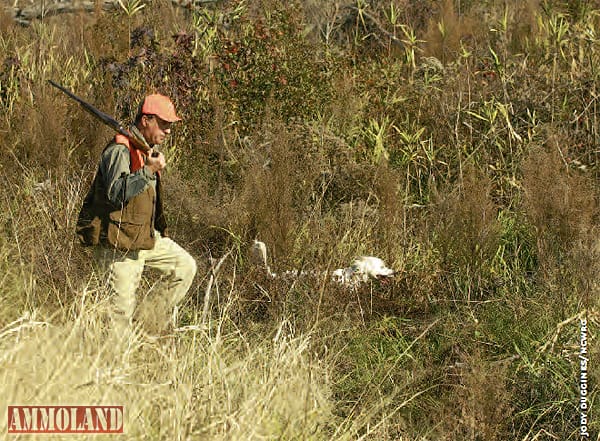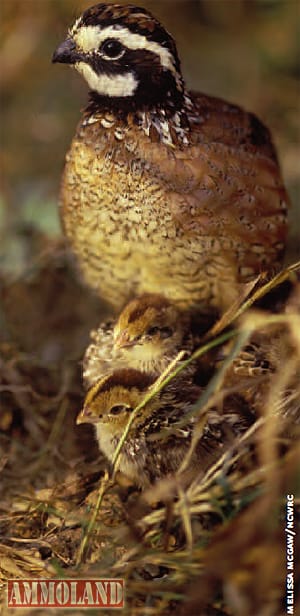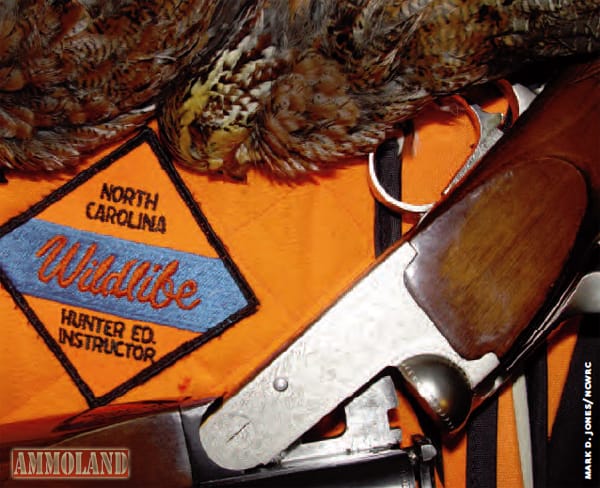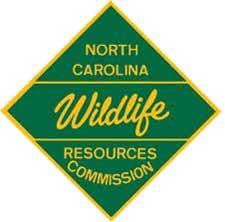By Mark D. Jones, Supervising Wildlife Biologist, NCWRC

RALEIGH, NC –-(Ammoland.com)- In the 2011 Fall issue of the Upland Gazette, we discussed factors behind the decline of the Northern bobwhite quail. It is well established that the problem is widespread throughout the range of bobwhites and does not come with easy solutions.
In fact, the required habitat changes are expensive, time-consuming, and difficult for the average hunter or even state wildlife agency to influence because of the need to impact huge acreages of mostly privately owned lands. The difficulty of impacting enough habitat to make a difference leads hunters to propose a variety of other solutions to the quail decline.
Let’s discuss a few one by one.
Many of our state’s hunters suggest we stock quail, similar to the traditions for fish such as trout. While this could provide a reliable supply of huntable birds for a short period each season, in my opinion, it would be a poor substitute for wild birds. Anyone who has ever witnessed a covey of wild bobwhite quail explode in front of a bird dog will understand this sentiment. I’ll let others debate the merits of stocking birds for providing short-term hunting opportunities, but if folks think stocking will help our wild quail situation, dozens of experiences from around the country tell a different tale. This is hard for hunters to accept because they often assume quail can be stocked just like wild turkeys, but the circumstances around the decline of the two species are much different.
Understanding the differences is critical to allowing hunters and agencies to make informed decisions.
Turkeys began declining over 100 years ago because their habitat was drastically degraded and because of excessive mortality as humans over-exploited them for food. However, turkey habitat began improving over much of the second half of the 1900s as forests recovered and the creation of state wildlife management agencies in the early and middle 1900s brought wise regulation of hunting seasons. A perfect storm of improving habitat and regulatory management allowed the highly adaptable turkey to be restored to improving unoccupied habitats across the United States.
The three keys to this successful turkey story were the recovery of habitats occurring in the late 1900s, an ability to manage mortality levels through regulatory measures by state wildlife agencies, and the adaptable nature of the turkey itself. Under this scenario, it made perfect sense to move turkeys into quality habitats without birds. The quail story does not qualify on any of these key points. Today, quail habitats continue to decline in both quality and quantity over most of the bird’s range, with no sign of recovery. Bobwhites experience very high natural mortality, making them difficult to impact with regulatory measures like hunting seasons, and quail are specialists (unlike wild turkeys), requiring specific habitats in order to reproduce and live out their daily lives.
Quail stocking has been attempted by many state agencies and private individuals with almost no success at establishing breeding populations in marginal habitats. The vast majority of wildlife biologists agree that stocking programs are a waste of resources and that our efforts are better spent working to improve habitat for existing birds.
Populations in these areas are often low simply because the amount of quality habitat is limited on our modern landscape.

Populations of quail are widespread across the Coastal Plain and found in scattered habitats of the Piedmont. Mountain quail populations are even more disjunct due to limited quality habitats. Without improving habitat conditions, there is little hope for stocking birds into any of these regions. Quail are a species capable of reproducing quickly when their habitat needs are met, but moving birds into inhospitable landscapes would be like dumping fish that need fast-moving, cold, clear water into a coastal swamp and expecting them to live in a sluggish, warm and muddy stream. Our best bet is to manage habitats and allow existing birds to inhabit quality habitat areas.
An example from a neighboring state illustrates this point. Wild quail were thought to be locally extinct in a county far on the periphery of this state’s known modern-day quail range. In recent years, major changes to cattle grazing practices occurred in this county as aging farmers reduced herd sizes due to multiple market forces. Then along came Miscanthus (Japanese silver grass), an aggressive species of non-native, introduced grass. This grass forced the next major land management change —the use of prescribed fire and flash grazing to control the spread of this invasive plant. All of a sudden, wild bobwhites were found in the areas formerly thought completely devoid of quail. Our neighbors report that it has been remarkable to watch quail populations increase in some of these areas when habitat improvements occurred. No quail were stocked; existing birds simply responded to newly available habitat.
Another suggested solution we commonly hear is that we need to kill predators. The decline of the U.S. fur market, and subsequent decline in trapper numbers and interest, has played a role in increased populations of mammalian predators such as raccoons, opossums, and foxes in recent decades. The ban on DDT, coupled with laws to protect hawks and owls, has increased populations of these birds of prey.
There is no doubt that there may be more predators today than in decades past when quail were more abundant. Because of legal status, we have to treat mammals and hawks separately when addressing any impact they may have on other wildlife. State wildlife agencies have full legal authority over resident mammal species and can pass laws and regulations to increase harvest or allow removal.
Before this is allowed, it is important to know if mammalian predators can be linked directly to the quail decline.
In order to shed light on this issue, N.C. Wildlife Resources Commission worked with researchers from N.C. State University and the Virginia Department of Game and Inland Fisheries on a comprehensive, long-term research project in the 1990s to test the removal of nest predators, including gray and red foxes, opossums, raccoons, and skunks (all species that eat eggs and kill chicks). The results from this four-year effort told us that the control of these predators will not increase quail populations without the addition of significant acreages of improved quail habitat.
It is also important to understand that we were able to implement a level of predator removal that would be difficult, if not impossible, for the average landowner to achieve, because we used full-time, paid trappers outside the normal trapping season. Most landowners will never implement such a full-scale effort at removing predators because of time and financial constraints. The take-home message from this work is that the control of mammalian predators alone will not improve quail populations, and I expect the level of mammalian predator control possible for the average landowner will have little effect on predator populations.
The situation regarding hawks is much different from that of mammals. Hawks, owls, and other raptors are protected by federal law that has its foundation in the Migratory Bird Treaty Act (an international treaty and the highest form of law in the United States). Let’s suppose for a minute the federal government would grant an exemption for killing raptors in special circumstances to increase quail populations.
Upland game enthusiasts and state wildlife agencies have worked for decades to build partnerships with habitat-oriented and bird conservation groups often made up of a mix of hunters and non-hunters. After all, habitat for quail and other game species is also habitat for high priority non-game wildlife species requiring the same conditions. Many members of these groups do not hunt but support the role of hunting in wildlife management and share common interests with hunters in terms of managing quality wildlife habitats.
If we implemented programs designed to kill raptors in order to increase quail numbers, our agency and our hunters would immediately lose the support of many of these groups who have been good partners in our wildlife habitat enhancement efforts over recent years.
The loss of partners and support from the general bird-loving public would far outweigh any minor benefits that quail might receive from fewer hawks. All this would occur without the existence of solid data showing that such control of birds of prey would even make a difference for bobwhites. And remember, this debate jumps over the huge hurdle of getting an exemption to the federal Migratory Bird Treaty Act to allow this control in the first place.
I sometimes wonder if the predator debate is not a serious waste of resources that could be better spent on habitat discussions and efforts. This is colored by my direct experiences hunting in the Great Plains over the last couple of decades where there are some of the densest populations of hawks, foxes, and raccoons I have ever seen. These areas also had quail populations that would make a North Carolina hunter feel like a kid at Christmas. What sets those areas apart is that they contain large expanses of year-round bobwhite quail habitat. Also, finding a place to hunt in those states is much easier because of the greater quantity of habitat. Any North Carolina hunter who is not convinced habitat is the key ingredient needs to travel to these states and see for himself.
Year-round habitat must address a quail’s needs in winter (food and cover for the leanest season), spring (courting and pre-nesting habitats), summer (nesting and chick-raising habitats), and fall (food and cover). There are few places left on the North Carolina landscape that provide all these components, but we do have examples of excellent quail habitat in the state with very high bird populations.
Biologists know how to produce quail given enough resources, acreages, and commitment from the landowner. Most of these areas are on intensively managed private lands such as our Corporate CURE (Cooperative Upland Restoration and habitat Enhancement) farms or on private quail hunting areas in eastern North Carolina. This management is expensive and requires a commitment from the landowner and/or farmer that simply does not exist in most areas and cannot be easily paid for with the amount of public funds likely to be available anytime in the foreseeable future. Historically high quail populations resulted from agricultural and forestry practices common in the late 1800s and early 1900s.
Southerners at that time were working hard to clear and farm a mostly forested landscape.
This work was done by hand and with work animals and created millions of acres of openings and near-perfect “messy” edge habitat preferred by bobwhites. Row crop farming, grazing, and forestry of these times were not dominated by technology or machinery and not particularly manicured, efficient or clean.
The resulting landscape of native grasses, briars, weeds, forbs, and shrubs was very favorable for quail.
Things began to change in the years after the Great Depression and World War II when technology came onto the scene. Agricultural and forestry practices became more and more technologically advanced. It became “normal” practice to do things that manicured or “cleaned” the landscape in an unfavorable manner for quail, and quail numbers have simply followed these changes through time in the last half-century. Because these land-use changes occurred for economic reasons, it will take new and economically sensible practices, implemented over huge areas, to increase bobwhite numbers.
Another neighboring state gives us an example of the importance of economics in the bobwhite equation. This state’s overall quail population has declined just as much, if not more, than ours. First, through coincidence, one county in this southern state’s Coastal Plain experienced an unusually high amount of timber harvest (thinning and clear-cuts) in local pine timberlands due to timber market forces beyond anyone’s control. This timber harvest was followed by the use of an unusual combination of herbicides to control competition with replanted trees.
These mixes were less lethal than normal for quail-friendly legumes and grasses. Secondly, two very large acreage landowners in the county implemented prescribed burning on several thousand acres. And thirdly, many local landowners implemented conservation practices, cost-shared by USDA Farm Bill funds, on croplands.
All of these changes came together at the same time for purely economic reasons in a perfect storm for bobwhite quail. Bobwhites temporarily responded to the unusual amount of new, quality habitats. One hunter reportedly found over 125 coveys and killed 225 quail in these areas last season. All of this occurred in an area very similar to our Coastal Plain landscape, which has millions of acres of row crop land and forest land managed for timber production. If this type of change to standard land management regimes was implemented over entire regions of Southern states, imagine the impact on quail populations!

Two Bobwhite Worlds
There are two bobwhite worlds that exist today. In one world, intensive habitat management produces bobwhites given adequate landowner commitment, finances, and acres. Scores of these areas exist throughout the South, and we have many right here in North Carolina. The average hunter will not set foot on these, and if you have access to such areas count yourself among the fortunate few. What we should learn from these areas is that there is no mystery about how to produce quail—the challenge is paying for it over larger areas.
That leads us to world number two: “The Real World”. This covers the vast majority of quail range where common land-use practices are driven by economics that determines the fate of quail. Lands are managed here by farmers, ranchers, and forest owners in ways they believe are economically sound. Whether biologists, hunters, and wildlife enthusiasts agree with this management does not matter.
Putting food on the table, sending children to college, and paying the loan on the tractor, truck, and seed comes first. I say this with no disrespect because I think most Americans would do the same. To address quail in this “Real World”, we won’t go into transect count details here, we have found that Savannah sparrows love the field borders in the winter. Songbird densities on these counts are always highest in the fallow areas and field borders versus pastures, crop fields, or woodlands. Other species that use the farm in the winter include American kestrels, northern harriers, swamp sparrows, song sparrows, and loggerhead shrikes.
Other uncommon or rare species that have been noted around the focal area from time to time include bobolinks, sandhill cranes, short-eared owls, barn owls, bald eagles, Eurasian collared doves, palm warblers, dickcissels, and a yellow-headed blackbird.
When one considers the abundance of bobwhite quail, and the observations of dozens of other birds utilizing our habitat areas, it is clear that the land management activities in the SEFA make it one of North Carolina’s premier areas for early-successional wildlife habitat. Few places in North Carolina, or anywhere in the South for that matter, have quail counts of 5.5 coveys per survey point. The response of quail and songbirds to habitat management in SEFA demonstrates that there is hope for declining farmland wildlife and that proven techniques for managing these species do work. Hopefully, as we move forward, we can continue to enroll additional farms in SEFA and provide information to inform other early-successional habitat efforts throughout North Carolina.
Finally, don’t forget to check out the NCWRC’s Special Hunts booklet for opportunities to apply for permit quail and rabbit hunts on these areas. These are, without a doubt, some of the best opportunities offered to sportsmen in the state. Information can be found for 2012–2013 hunts later this summer at ncwildlife.org/Licensing/PermitHuntingOpportunities.aspx.
About N.C. Wildlife Resources Commission
Since 1947, N.C. Wildlife Resources Commission has been dedicated to the conservation and sustainability of the state’s fish and wildlife resources through research, scientific management, wise use, and public input. The Commission is the state regulatory agency responsible for the enforcement of fishing, hunting, trapping and boating laws and provides programs and opportunities for wildlife-related educational, recreational and sporting activities. To learn more, visit www.ncwildlife.org.

